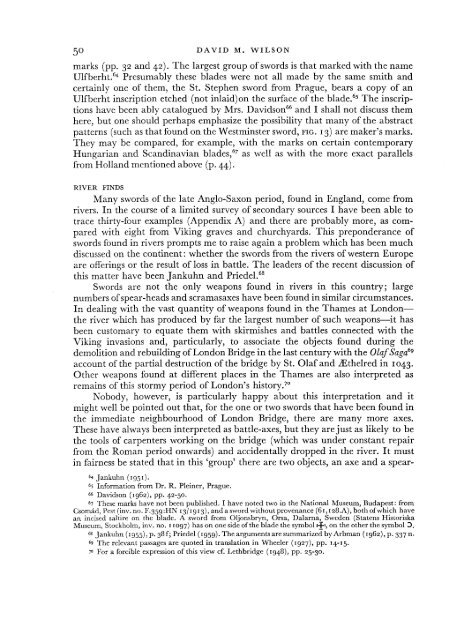Some Neglected Late Anglo-Saxon Swords - Archaeology Data ...
Some Neglected Late Anglo-Saxon Swords - Archaeology Data ...
Some Neglected Late Anglo-Saxon Swords - Archaeology Data ...
Create successful ePaper yourself
Turn your PDF publications into a flip-book with our unique Google optimized e-Paper software.
50 DAVID M. WILSON<br />
marks (pp. 32 and 42). The largest group ofswords is that marked with the name<br />
Ulf'berht.?' Presumably these blades were not all made by the same smith and<br />
certainly one of them, the St. Stephen sword from Prague, bears a copy of an<br />
Ulfberht inscription etched (not inlaid)on the surface of the blade.v' The inscriptions<br />
have been ably catalogued by Mrs. Davidson'" and I shall not discuss them<br />
here, but one should perhaps emphasize the possibility that many of the abstract<br />
patterns (such as that found on the Westminster sword, FIG. 13) are maker's marks.<br />
They may be compared, for example, with the marks on certain contemporary<br />
Hungarian and Scandinavian blades." as well as with the more exact parallels<br />
from Holland mentioned above (p. 44).<br />
RIVER FINDS<br />
Many swords of the late <strong>Anglo</strong>-<strong>Saxon</strong> period, found in England, come from<br />
rivers. In the course of a limited survey of secondary sources I have been able to<br />
trace thirty-four examples (Appendix A) and there are probably more, as compared<br />
with eight from Viking graves and churchyards. This preponderance of<br />
swords found in rivers prompts me to raise again a problem which has been much<br />
discussed on the continent: whether the swords from the rivers ofwestern Europe<br />
are offerings or the result of loss in battle. The leaders of the recent discussion of<br />
this matter have been Jankuhn and Priede1. 68<br />
<strong>Swords</strong> are not the only weapons found in rivers in this country; large<br />
numbers of spear-heads and scramasaxes have been found in similar circumstances.<br />
In dealing with the vast quantity of weapons found in the Thames at Londonthe<br />
river which has produced by far the largest number of such weapons-it has<br />
been customary to equate them with skirmishes and battles connected with the<br />
Viking invasions and, particularly, to associate the objects found during the<br />
demolition and rebuilding ofLondon Bridge in the last century with the OlafSaga 69<br />
account ofthe partial destruction ofthe bridge by St. Olafand .tEthelred in 1043.<br />
Other weapons found at different places in the Thames are also interpreted as<br />
remains of this stormy period of London's history.?"<br />
Nobody, however, is particularly happy about this interpretation and it<br />
might well be pointed out that, for the one or two swords that have been found in<br />
the immediate neighbourhood of London Bridge, there are many more axes.<br />
These have always been interpreted as battle-axes, but they arejust as likely to be<br />
the tools of carpenters working on the bridge (which was under constant repair<br />
from the Roman period onwards) and accidentally dropped in the river. It must<br />
in fairness be stated that in this 'group' there are two objects, an axe and a spear-<br />
64 Jankuhn (1951).<br />
65 Information from Dr. R. Pleiner, Prague.<br />
66 Davidson (1962), pp. 42-50.<br />
67 These marks have not been published. I have noted two in the National Museum, Budapest: from<br />
Csornad, Pest (inv. no. F.359:HN 13/1913), and a sword without provenance (61,128.A), both ofwhich have<br />
an incised saltire on the blade. A sword from Oljonsbryn, Orsa, Dalarna, Sweden (Statens Historiska<br />
Museum, Stockholm, inv. no. 11097) has on one side ofthe blade the symbol s-j-i,on the other the symbol :::>.<br />
68 Jankuhn (1955), p. 38 f; Priedel (1959). The arguments are summarized by Arbman (1962), p. 337 rt,<br />
69 The relevant passages are quoted in translation in Wheeler (1927), pp. 14-15.<br />
7" For a forcible expression of this view cr. Lethbridge (1948), pp. 25-30.

















